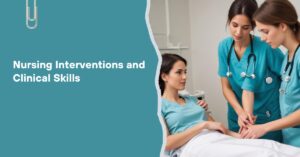The human resource aspect of any healthcare sector is fundamental, given the ever-changing demography of the healthcare industry. These are the most important resources that act as a backbone in healthcare delivery systems, be it highly trained personnel, effective health equipment, or sophisticated technologies. They indicate that due to ineffective management practices, there needs to be more utilized resources, and ultimately, the patients, as well as the nursing facilities, are deprived of the best solutions they require.
Leadership and management challenges can exert negative consequences on the ability of nursing resources to deliver patient care properly due to the reduced efficiency of these resources. Lack of proper planning, poor means to allocate resources, and effective monitoring may result in a number of problems that range from low performance to higher expenses and threats to the lives of patients.
A review of the effects of poor management can help identify areas for change and assist in developing practices that will optimize resource allocation and improve healthcare services.
Importance of Nursing Resources
Table of Contents
ToggleNursing resources are the most significant part of the overall accomplishment of health care support since they are the principal support and the workhorse of the health care division. This must be considered as the enhancement of staff competence and equipment, which is central to the provision of quality patient care amid risk factors. Being one of the largest professional groups involved in direct patient care, the role of nurses is associated with the treatment implementation, the constant assessment of the patient’s state, and patients’ rights representation.
Categories of Nursing Resources
Nursing resources refer to a complex of components that are vital to the provision of sufficient levels of care to meet the patient’s or consumer’s needs. These resources can be broadly categorized into four main categories.
Human Resources
Human resources refer to the pillar of any institution because they are the individuals involved in the practice, such as the nurses, nursing attendants, and other employees. They are one of the most valuable assets in healthcare facilities since they are directly involved in the administration of treatment to patients and intervention in the social welfare of patients and families. Human resources, in this case, also encompass other people such as educators, managers, and leaders who help in cultivating professional and leadership aspects of nursing teams.
Material Resources
Equipment and Supplies refer to all the physical and tangible commodities that are required as input for the actualization of nursing practice and include medical equipment, medicines, and consumable materials. Furniture like hospital bed monitors for tracking patients’ status in terms of vital signs and diagnostic tools facilitate the evaluation of patients and their overall management. Drugs and any related materials like sutures, scalpels, gloves, and other instruments and fluids like saline solution or other fluids are essential in attending to patients and in controlling and treating illnesses and diseases.
Financial Resources
Financial assets include the funds, revenue, and subsidies required and available for the financing of nursing practice and other healthcare activities. A sufficient amount of funds is necessary to attract and retain competent nursing employees, sustain the healthcare facilities, and innovate by purchasing new equipment or enhancing existing ones. Monetary resources also fund staff training programs for further education, research activities, and other service enhancement endeavors oriented toward patients’ well-being improvement.
Technological Resources
Technological resources refer to the tools, systems, and digital platforms utilized in nursing practice to enhance efficiency, accuracy, and communication. Electronic health records (EHRs), telehealth platforms, and clinical decision support systems are examples of technological resources that streamline documentation, facilitate remote patient monitoring, and support clinical decision-making. Technological resources also include medical devices, such as infusion pumps, ventilators, and cardiac monitors, which play an important role in diagnosing and treating patients across various healthcare settings.
Resource Utilization in Nursing
Effective resource utilization is essential to maintaining quality standards of care and maximizing operational efficiency in healthcare organizations. In this section, we discuss the importance of effective resource utilization in nursing practice and explore strategies to optimize resource allocation.
Importance of Effective Utilization of Resources
- Improving Patient Care: Effective resource utilization ensures that patients receive timely, appropriate care, which improves health outcomes and increases satisfaction.
- Maximizing Operational Efficiency: Appropriate resource allocation can minimize waste, reduce unnecessary costs, and streamline workflows, thereby improving overall operational efficiency.
- Supporting Staff Satisfaction: Appropriate resource allocation can promote a positive work environment, reduce stress among healthcare professionals, and increase job satisfaction among nursing staff.
Strategies for Effective Resource Utilization
- Prioritization techniques
- Prioritize patient care tasks based on understanding the patient’s condition and urgency of needs.
- Implement time-saving techniques such as batching, delegation, and efficient scheduling to streamline workflow.
- Optimization methods
- Use algorithms and decision support tools to effectively allocate resources, taking into account factors such as patient condition, staff availability, and resource availability.
- Train staff in multiple skills to increase flexibility and adaptability in resource use and enable them to perform a variety of tasks as needed.
- Technology integration
- Use EHR systems to streamline documentation processes, access real-time patient information, and facilitate communication between healthcare team members.
- Implement telehealth solutions and remote monitoring technologies to expand access to healthcare services, especially in underserved areas or during emergency situations.
Challenges Faced by Nurse Leaders
They support and lead Nursing management leads and Nurse teams to ensure Nursing teams collaborate, improve actions, and achieve the goals of organizations, leading to successful patient outcomes. Here are some challenges that nurse leaders might face.
Staffing Shortages
Occasionally, nurse leaders are faced with staffing shortages, due to high turnover rates, retirements, and workforce shortages. This can result in compromised nursing resources and exacerbated workload, which may hinder the quality of patient care.
Budget Constraints
These nurse workforce leaders experience obstacles in their efforts to determine staffing ratios and schedule employees due to financial and resource limitations. Financial constraints affect the equal distribution of available resources.
Technology Integration
In a process that involves trying to cut through the fog, nurse leaders need to manage efforts to integrate new technologies into practice, assuring that staff are trained in their use, and that systems are interoperable and easy to use.
Regulatory Compliance
As a nurse leader, one should constantly aim to stay well-informed about new and changing regulatory requirements and accreditation standards while playing catch-up to new and changing policies, procedures, and quality metrics. One should also manage conflicting priorities simultaneously.
Strategies for Addressing Challenges
- Develop and implement strategic plans that align with organizational goals, prioritize resource allocation, and address staffing and budgetary constraints.
- Invest in user-friendly technology solutions that streamline workflow processes, enhance communication, and improve patient care delivery.
- Foster a culture of continuous learning and professional growth, providing opportunities for staff development, mentorship, and career advancement.
- Embrace collaborative leadership approaches that empower nursing staff to contribute to decision-making processes, fostering a sense of ownership and accountability.
Resource Imbalancing
Resource imbalance occurs when there is a mismatch between the supply and demand of resources, leading to shortages, excesses, or disparities in resource allocation. Resource imbalance refers to inequalities in the allocation and distribution of resources within healthcare settings, resulting in inefficiencies, inequities, and challenges in delivering optimal patient care. In this section, we will explore the concept of resource imbalance, its causes, consequences, and strategies for addressing it effectively.
Causes of Resource Imbalance
- Budgetary constraints
- Staffing shortages
- Inadequate infrastructure
- Geographic disparities
- Demographic factors
- Regulatory barriers
You can also check out our Sample Papers
- NURS FPX 4010 Assessment 1 – Collaboration and Leadership Reflection Video
- NURS FPX 4010 Assessment 2 – Interview and Interdisciplinary Issue Identification
- NURS FPX 4010 Assessment 3
- NURS FPX 4010 Assessment 4 – Stakeholder Presentation
What are the signs of poor management?
- Clear communication is fundamental in any organization, and its absence, marked by unclear directives or inconsistent messaging, can lead to clarity and efficiency.
- A reluctance to embrace change can stifle innovation and hinder the company’s ability to adapt to evolving market dynamics.
- Effective delegation is essential for managerial success, and failure in this area can lead to overwhelmed managers and underdeveloped teams.
- A lack of recognition for employee achievements can result in low morale and disengagement.
- Consistent, constructive feedback is vital for employee development, and its absence or inconsistency can lead to performance issues.
- Overworking employees without sufficient rest can contribute to burnout and decreased productivity, ultimately harming both individuals and the organization.
- Neglecting employee development initiatives can hinder the growth potential of both individuals and the company as a whole.
Why is poor management a problem?
Poor management poses several significant problems for organizations. Firstly, it can lead to decreased employee morale and motivation. When employees feel undervaluedthey are less likely to be engaged in their work, leading to reduced productivity and creativity. Secondly, poor management often results in high turnover rates, which can be costly for companies due to recruitment and training expenses, as well as the loss of institutional knowledge and experienced employees.
Additionally, ineffective management can hinder teamwork and collaboration, as well as the implementation of strategic initiatives. This can lead to missed opportunities for growth and innovation, ultimately impacting the organization’s competitiveness in the market. Management can also result in legal and regulatory issues if it does not correctly address compliance requirements or ethical standards.
Conclusion
Efficient utilization of nursing resources is essential for delivering high-quality patient care and achieving organizational goals. By addressing the impact of poor management on resource utilization and implementing effective strategies, healthcare organizations can maximize the potential of nursing resources and enhance overall healthcare delivery.







